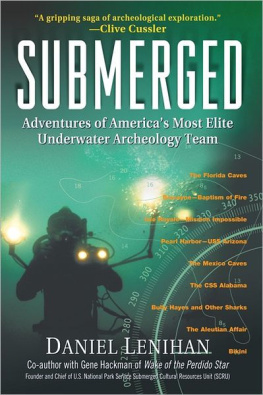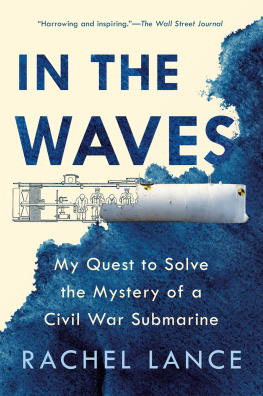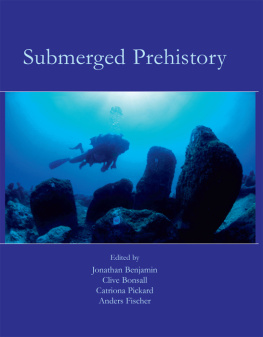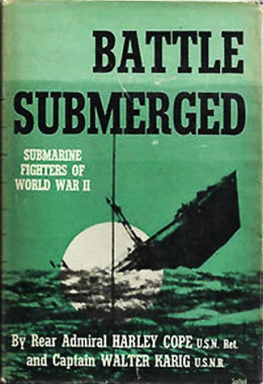Critical to making this book a reality were Noah Lukeman, an agent for all seasons; Esther Margolis, a grand lady of publishing; and Keith Hollaman, for his calm and sure editorial guidance. For early encouragement and for the title, I thank Ron Schultz. Also, for early encouragement and assistance in writing endeavors, Bob Utley, Melody Webb, and Vittorio Maestro and the editorial staff of my favorite magazine, Natural History. A special note of gratitude to my sister Patricia.
For unflagging support of the Submerged Cultural Resources Unit over the years: Doug Scovill, Jack Morehead, John Cook, Bob Kerr, Deny Galvin, Don Neubacher, Rob Arnberger, Mike Finley, Karen Wade, Rick Smith, Dick Sellars, and Ernest Ortega. Thanks to all the members of the SCRU team, present and past, particularly Larry Murphy.
To my wife Barbara for counsel, for keeping it all together, and in the sincere hope she will finally recommend something I have authored to the ladies of her reading group.
DANIEL LENIHAN is not just an explorer, but a preservationist; not just a risk-taker, but a nationally recognized scientist, respected in the ranks of park rangers. He has been at the center of many major underwater research projects in the U.S., from the USS Arizona in Pearl Harbor to the first expedition to resurvey the sunken ships of Bikini Atoll after they were declared radioactive from nuclear blasts.
Lenihan has been diving as a park ranger and archeologist for the National Park Service (NPS) since 1972. In 1976, he developed the only federal underwater archeological team in the U.S. and, in 1980, was appointed the first chief of the NPS Submerged Cultural Resources Unit (SCRU).
Over the last 25 years, Lenihan and the SCRU team have been the subject of national media stories and many TV documentaries on CBS, ABC, BBC, CNN, PBS, The Discovery Channel, and National Geographic. He has written frequently for Natural History and American History, and coauthored with Gene Hackman two well-received novels, Wake of the Perdido Star and Justice for None. A native New Yorker and former schoolteacher, he lives with his family in Santa Fe, New Mexico.
Australia
HarperCollins Publishers (Australia) Pty. Ltd.
Level 13, 201 Elizabeth Street
Sydney, NSW 2000, Australia
http://www.harpercollins.com.au
Canada
HarperCollins Canada
2 Bloor Street East - 20th Floor
Toronto, ON, M4W, 1A8, Canada
http://www.harpercollins.ca
New Zealand
HarperCollins Publishers (New Zealand) Limited
P.O. Box 1
Auckland, New Zealand
http://www.harpercollins.co.nz
United Kingdom
HarperCollins Publishers Ltd.
77-85 Fulham Palace Road
London, W6 8JB, UK
http://www.harpercollins.co.uk
United States
HarperCollins Publishers Inc.
10 East 53rd Street
New York, NY 10022
http://www.harpercollins.com
Justice for None (with Gene Hackman)
Wake of the Perdido Star (with Gene Hackman)
Underwater Wonders of the National Parks (with John Brooks)
The Shipwrecks of Isle Royale National Park:
The Archeological Survey (Editor)
The foghorn from the Rock of Ages light at the southern end of Isle Royale National Park wails ominously every five seconds. Its usual dreamy quality is strangely foreboding, oppressive this afternoon. There is no fog about our boat, though the lighthouse is shrouded with wisps of Lake Superior mist. Patches of sunlight play over the glass-calm water surrounding five National Park Service divers grouped on the fantail of the thirty-eight foot motor vessel Superior Diver. The date is June 15, 1982. No one speaks as we intently study the emerald-green expanse of Lake Superior from the stern of our anchored vessel. No flicker of movement, no slick undulating circle disturbs the verdant glassnothing that would indicate the presence of a divers bubbles boiling to the surface. They are late... very late, and unspoken fear is tangible. The rising tension has become a sixth member of the team gathered on the deck.
A stopwatch suspended to a clipboard at the divemaster station ticks relentlessly. The mundane instrument has suddenly assumed an unprecedented degree of importance. If the ticking isnt an indicator that hope is fleeting fast, the foghorns plaintive wailing leaves no room for doubt.
I am conscious of a faint slapping against the hull from the wake of a passing boat, and the damp smell of lake water steaming off the recently doffed neoprene dive suits lying on the deck. Body heat, a sign of life; its not hard to make a connection to the two suits still more than one hundred feet below in the thirty-four degree lake water.
Lake Superior is not the Caribbeanit is cold, harsh, and extracts heavy penalties for even small mistakes. I have dived over the hulks of many ships that have felt its power, when its explosive temper had turned the placid lake surface into a raging cauldron of foam and freezing spray. Twisted steel and smashed wood mingled at the bottom with the toys of children, bodies of sailorsit is the story we are here to tell. Our task is to unravel the archeological residues of the human dramas that played out in these waters and match them to the written records of the past.
Below us lie the casualties that resulted from the pursuit of great profits in the industrial hotbed of the Great Lakes at the turn of the twentieth century. One more voyage, just one more capital-driven run, taunting the gales of November. How easy it is for us, swimming over the cadavers of ships through silent depths, ice water in our veins, to relate to the victims of disaster; archeology and history had come alive to us on this lake. Now two of our people, like many a Great Lakes ship, had gone missing.
Our divers are meticulous about tracking their bottom timethe period from leaving the surface until the return to the decompression area, a place under the boat that serves as a safe haven. Here they can switch from air tanks on their backs to breathe pure oxygen from regulators attached to long hoses suspended from large green cylinders strapped to the deck; they have unlimited time to slowly complete a safe ascent.
Before they had exceeded their planned arrival time by a full minute, the surface spotter registered enough concern that others began gathering around him, peering into the distance and checking the clipboard notation of the divers descent time. When I heard the shuffling of feet and spied the hunched-over form heading toward my bunk, I was already getting my shoes on. The voice inflection of the crew, lack of an undercurrent of banter, and sudden muting of the Waylon Jennings tape alerted me that something was wrong as effectively as an alarm bell.
During the previous decade supervising hazardous diving operations, I had occasionally wondered how I might react to losing a member of my team. I find now that part of my consciousness is operating at warp speed, looking for solutions, while another part stifles images of drowned divers that, unbidden, keep trying to emerge from my memory.
Seconds later, I become strangely detached, reflective. I notice little things, like Jerry Livingstons hands. Our diving illustrator has strong sensitive hands, those of an artist. Where he leans on the rail, his knuckles are starkly white. He has spoken not a word but his hands tell it all: He thinks theyre in serious trouble. If this lake were a forgiving place, we wouldnt be here, anchored off Isle Royale, diving on the broken hulks of ten large ships. Archeologists seldom get to pick where they will dive but almost by definition the area wont be benign.
Next page









